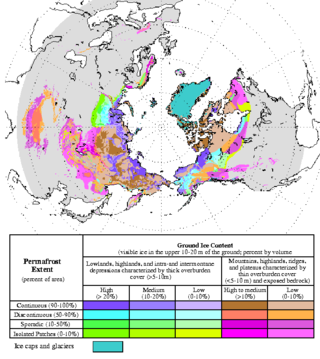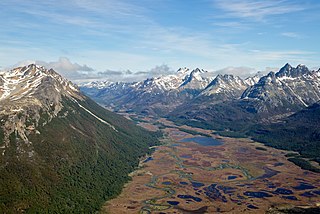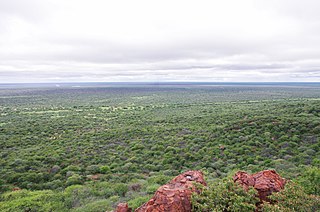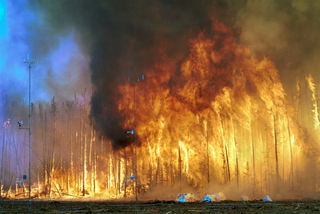Related Research Articles

In physical geography, tundra is a type of biome where tree growth is hindered by frigid temperatures and short growing seasons. The term tundra comes through Russian тундра from the Kildin Sámi word тӯндар meaning "uplands", "treeless mountain tract". There are three regions and associated types of tundra: Arctic tundra, alpine tundra, and Antarctic tundra.

The cryosphere is an all-encompassing term for the portions of Earth's surface where water is in solid form, including sea ice, lake ice, river ice, snow cover, glaciers, ice caps, ice sheets, and frozen ground. Thus, there is a wide overlap with the hydrosphere. The cryosphere is an integral part of the global climate system with important linkages and feedbacks generated through its influence on surface energy and moisture fluxes, clouds, precipitation, hydrology, atmospheric and oceanic circulation.

Peat is an accumulation of partially decayed vegetation or organic matter. It is unique to natural areas called peatlands, bogs, mires, moors, or muskegs. Sphagnum moss, also called peat moss, is one of the most common components in peat, although many other plants can contribute. The biological features of sphagnum mosses act to create a habitat aiding peat formation, a phenomenon termed 'habitat manipulation'. Soils consisting primarily of peat are known as histosols. Peat forms in wetland conditions, where flooding or stagnant water obstructs the flow of oxygen from the atmosphere, slowing the rate of decomposition. Peat properties such as organic matter content and saturated hydraulic conductivity can exhibit high spatial heterogeneity.

Permafrost is soil or underwater sediment which continuously remains below 0 °C (32 °F) for two years or more: the oldest permafrost had been continuously frozen for around 700,000 years. While the shallowest permafrost has a vertical extent of below a meter, the deepest is greater than 1,500 m (4,900 ft). Similarly, the area of individual permafrost zones may be limited to narrow mountain summits or extend across vast Arctic regions. The ground beneath glaciers and ice sheets is not usually defined as permafrost, so on land, permafrost is generally located beneath a so-called active layer of soil which freezes and thaws depending on the season.
Yedoma is an organic-rich Pleistocene-age permafrost with ice content of 50–90% by volume. Yedoma are abundant in the cold regions of eastern Siberia, such as northern Yakutia, as well as in Alaska and the Yukon.

Major environmental issues caused by contemporary climate change in the Arctic region range from the well-known, such as the loss of sea ice or melting of the Greenland ice sheet, to more obscure, but deeply significant issues, such as permafrost thaw, as well as related social consequences for locals and the geopolitical ramifications of these changes. The Arctic is likely to be especially affected by climate change because of the high projected rate of regional warming and associated impacts. Temperature projections for the Arctic region were assessed in 2007: These suggested already averaged warming of about 2 °C to 9 °C by the year 2100. The range reflects different projections made by different climate models, run with different forcing scenarios. Radiative forcing is a measure of the effect of natural and human activities on the climate. Different forcing scenarios reflect things such as different projections of future human greenhouse gas emissions.

Arctic methane release is the release of methane from seas and soils in permafrost regions of the Arctic. While it is a long-term natural process, methane release is exacerbated by global warming. This results in a positive feedback cycle, as methane is itself a powerful greenhouse gas.

Climate change feedbacks are effects of global warming that amplify or diminish the effect of forces that initially cause the warming. Positive feedbacks enhance global warming while negative feedbacks weaken it. Feedbacks are important in the understanding of climate change because they play an important part in determining the sensitivity of the climate to warming forces. Climate forcings and feedbacks together determine how much and how fast the climate changes. Large positive feedbacks can lead to tipping points—abrupt or irreversible changes in the climate system—depending upon the rate and magnitude of the climate change.

The permafrost carbon cycle or Arctic carbon cycle is a sub-cycle of the larger global carbon cycle. Permafrost is defined as subsurface material that remains below 0o C for at least two consecutive years. Because permafrost soils remain frozen for long periods of time, they store large amounts of carbon and other nutrients within their frozen framework during that time. Permafrost represents a large carbon reservoir, one which was often neglected in the initial research determining global terrestrial carbon reservoirs. Since the start of 2000s, however, far more attention has been paid to the subject, with an enormous growth both in general attention and in the scientific research output.

A peatland is a type of wetland whose soils consist of organic matter from decaying plants, forming layers of peat. Peatlands arise because of incomplete decomposition of organic matter, usually litter from vegetation, due to water-logging and subsequent anoxia. Like coral reefs, peatlands are unusual landforms that derive mostly from biological rather than physical processes, and can take on characteristic shapes and surface patterning.
Increasing methane emissions are a major contributor to the rising concentration of greenhouse gases in Earth's atmosphere, and are responsible for up to one-third of near-term global heating. During 2019, about 60% of methane released globally was from human activities, while natural sources contributed about 40%. Reducing methane emissions by capturing and utilizing the gas can produce simultaneous environmental and economic benefits.

Woody plant encroachment is a natural phenomenon characterised by the increase in density of woody plants, bushes and shrubs, at the expense of the herbaceous layer, grasses and forbs. It predominantly occurs in grasslands, savannas and woodlands and can cause biome shifts from open grasslands and savannas to closed woodlands. The term bush encroachment refers to the expansion of native plants and not the spread of alien invasive species. It is thus defined by plant density, not species. Bush encroachment is often considered an ecological regime shift and can be a symptom of land degradation. The phenomenon is observed across different ecosystems and with different characteristics and intensities globally.

The soil carbon feedback concerns the releases of carbon from soils in response to global warming. This response under climate change is a positive climate feedback. There is approximately two to three times more carbon in global soils than the Earth's atmosphere, which makes understanding this feedback crucial to understand future climate change. An increased rate of soil respiration is the main cause of this feedback, where measurements imply that 4 °C of warming increases annual soil respiration by up to 37%.

Terrestrial ecosystems found in the boreal regions of North America and Eurasia cover less than 17% of the earth's land surface, yet contain more than 30% of all carbon present in the terrestrial biome. In terms of carbon storage, the boreal region consists of three ecosystems: boreal forest, peatland, and tundra. Vast areas of the globe and are contributing greatly to atmospheric carbon release due to increased temperature and fire hazard. High northern latitudes will experience the most significant increase in warming on the planet as a result of increased atmospheric greenhouse gases thus placing in jeopardy the carbon sink in these areas. In addition to the release of carbon through the melting of permafrost, high intensity wildfires will become more common and thus contribute to the release of stored carbon. This means that the boreal forest and its fire regime is becoming an increasingly more significant factor in determining the global carbon budget.
Susan M. Natali is an American ecologist. She is the Arctic program director and senior scientist at the Woodwell Climate Research Center, where her research focuses on the impact of climate change on terrestrial ecosystems, primarily on Arctic permafrost. She is also the project lead for Permafrost Pathways, a new initiative launched in 2022 with funding from TED's Audacious Project. On Monday, April 11, 2022, Dr. Natali gave a TED Talk introducing the Permafrost Pathways project at the TED2022 conference in Vancouver, BC.
Dale Hadley Vitt is an American bryologist and peatland ecologist, recognized as a leading expert on peatlands. From 1989 to 1991 he was the president of the American Bryological and Lichenological Society.
Margaret Torn is an ecologist at Lawrence Berkeley National Laboratory known for her research on carbon cycling, especially with respect to the interactions between soils and the atmosphere.
Michelle Cailin Mack is an ecologist working on the connections between plants and climate in polar regions. She is a fellow of the Ecological Society of America and the American Geophysical Union. She currently holds the title of Regent's Professor at Northern Arizona University.
Merritt Turetsky is an American ecosystem ecologist and a professor at the University of Colorado Boulder. She currently serves as the Director of Arctic Security for the University of Colorado. She served as the first woman Director of the Institute for Arctic and Alpine Research (INSTAAR) from 2019-2023. Her research considers fire regimes, climate change and biogeochemical cycling in Arctic wetlands. Turetsky is a member of the Permafrost Action Team (SEARCH), a group of scientists who translate and deliver science to decision-makers.
Retrogressive thaw slumps (RTS), are a type of landslide that occur in the terrestrial Arctic's permafrost region of the circumpolar Northern Hemisphere when an ice-rich section thaws. RTSs develop quickly and can extend across several hectares modifying Arctic coastlines and permafrost terrain. They are the most active and dynamic feature of thermokarst—the collapse of the land surface as ground ice melts. They are thermokarst slope failures due to abrupt thawing of ice-rich permafrost or glaciated terrains. These horseshoe-shaped landslides contribute to the thawing of hectares of permafrost annually and are considered to be one of the most active and dynamic features of thermokarst—the "processes and landforms that involve collapse of the land surface as a result of the melting of ground ice." They are found in permafrost or glaciated regions of the Northern Hemisphere—the Tibetan Plateau, Siberia, from the Himalayas to northern Greenland, and in northern Canada's Northwest Territories (NWT), the Yukon Territories, Nunavut, and Nunavik and in the American state of Alaska. The largest RTS in the world is in Siberia—the Batagaika Crater, also called a "megaslump", is one-kilometre-long and 100 metres (330 ft) deep and it grows a 100 feet (30 m) annually. The land began to sink, and the Batagaika Crater began to form in the 1960s, following clear-cutting of a section of forested area.
References
- 1 2 "Jennifer Harden, Ph.D." Retrieved 16 August 2021.
- 1 2 "Historic Fellows | American Association for the Advancement of Science". www.aaas.org. Retrieved 16 August 2021.
- 1 2 "Harden". Honors Program. Retrieved 16 August 2021.
- ↑ Harden, Jennifer (1982). A study of soil development using the geochronology of Merced river deposits, California (Thesis).
- ↑ Harden, Jennifer W. (1982-07-01). "A quantitative index of soil development from field descriptions: Examples from a chronosequence in central California". Geoderma. 28 (1): 1–28. Bibcode:1982Geode..28....1H. doi:10.1016/0016-7061(82)90037-4. ISSN 0016-7061.
- ↑ Harden, Jennifer W.; Taylor, Emily M. (1983). "A Quantitative Comparison of Soil Development in Four Climatic Regimes". Quaternary Research. 20 (3): 342–359. Bibcode:1983QuRes..20..342H. doi:10.1016/0033-5894(83)90017-0. ISSN 0033-5894. S2CID 129497217.
- ↑ Harden, Jennifer W. (1990). "Soil development on stable landforms and implications for landscape studies". Geomorphology. 3 (3–4): 391–398. Bibcode:1990Geomo...3..391H. doi:10.1016/0169-555X(90)90013-G.
- ↑ Goulden, M. L.; Wofsy, S. C.; Harden, J. W.; Trumbore, S. E.; Crill, P. M.; Gower, S. T.; Fries, T.; Daube, B. C.; Fan, S.-M.; Sutton, D. J.; Bazzaz, A. (1998-01-09). "Sensitivity of Boreal Forest Carbon Balance to Soil Thaw". Science. 279 (5348): 214–217. Bibcode:1998Sci...279..214G. doi:10.1126/science.279.5348.214. ISSN 0036-8075. PMID 9422691. S2CID 7530001.
- ↑ Harden, J. W.; Sharpe, J. M.; Parton, W. J.; Ojima, D. S.; Fries, T. L.; Huntington, T. G.; Dabney, S. M. (1999). "Dynamic replacement and loss of soil carbon on eroding cropland". Global Biogeochemical Cycles. 13 (4): 885–901. Bibcode:1999GBioC..13..885H. doi: 10.1029/1999GB900061 . ISSN 1944-9224.
- ↑ Harden, J. W.; Mark, R. K.; Sundquist, E. T.; Stallard, R. F. (1992-12-18). "Dynamics of Soil Carbon During Deglaciation of the Laurentide Ice Sheet". Science. 258 (5090): 1921–1924. Bibcode:1992Sci...258.1921H. doi:10.1126/science.258.5090.1921. ISSN 0036-8075. PMID 17836185. S2CID 28220872.
- ↑ Harden, J. W.; Trumbore, S. E.; Stocks, B. J.; Hirsch, A.; Gower, S. T.; O'neill, K. P.; Kasischke, E. S. (2000). "The role of fire in the boreal carbon budget". Global Change Biology. 6 (S1): 174–184. Bibcode:2000GCBio...6S.174H. doi:10.1046/j.1365-2486.2000.06019.x. ISSN 1365-2486. PMID 35026928. S2CID 86434480.
- ↑ Harden, J. W.; Neff, J. C.; Sandberg, D. V.; Turetsky, M. R.; Ottmar, R.; Gleixner, G.; Fries, T. L.; Manies, K. L. (2004). "Chemistry of burning the forest floor during the FROSTFIRE experimental burn, interior Alaska, 1999". Global Biogeochemical Cycles. 18 (3). Bibcode:2004GBioC..18.3014H. doi:10.1029/2003GB002194. ISSN 1944-9224. S2CID 18315843.
- ↑ Harden, Jennifer W.; Manies, Kristen L.; Turetsky, Merritt R.; Neff, Jason C. (2006). "Effects of wildfire and permafrost on soil organic matter and soil climate in interior Alaska". Global Change Biology. 12 (12): 2391–2403. Bibcode:2006GCBio..12.2391H. doi:10.1111/j.1365-2486.2006.01255.x. ISSN 1365-2486. S2CID 86632152.
- ↑ Turetsky, Merritt R.; Kane, Evan S.; Harden, Jennifer W.; Ottmar, Roger D.; Manies, Kristen L.; Hoy, Elizabeth; Kasischke, Eric S. (2011). "Recent acceleration of biomass burning and carbon losses in Alaskan forests and peatlands". Nature Geoscience. 4 (1): 27–31. Bibcode:2011NatGe...4...27T. doi:10.1038/ngeo1027. ISSN 1752-0894.
- ↑ Preuss, Paul (April 2007). "Science@Berkeley Lab: Damaged Land, Buried Carbon". www2.lbl.gov. Retrieved 2021-08-20.
- ↑ Berhe, Asmeret Asefaw; Harte, John; Harden, Jennifer W.; Torn, Margaret S. (2007-04-01). "The Significance of the Erosion-induced Terrestrial Carbon Sink". BioScience. 57 (4): 337–346. doi: 10.1641/B570408 . ISSN 1525-3244. S2CID 54758860.
- ↑ "Not-so-permanent permafrost: 850 billion tons of carbon stored in frozen Arctic ground could be released". ScienceDaily. October 25, 2012. Retrieved 2021-08-20.
- ↑ Harden, Jennifer W.; Koven, Charles D.; Ping, Chien-Lu; Hugelius, Gustaf; David McGuire, A.; Camill, Phillip; Jorgenson, Torre; Kuhry, Peter; Michaelson, Gary J.; O'Donnell, Jonathan A.; Schuur, Edward A. G. (2012-08-16). "Field information links permafrost carbon to physical vulnerabilities of thawing: C AND N VULERABLITIES OF THAWING". Geophysical Research Letters. 39 (15). doi:10.1029/2012GL051958. S2CID 15126894.
- ↑ Hugelius, G.; Strauss, J.; Zubrzycki, S.; Harden, J. W.; Schuur, E. A. G.; Ping, C.-L.; Schirrmeister, L.; Grosse, G.; Michaelson, G. J.; Koven, C. D.; O'Donnell, J. A. (2014-12-01). "Estimated stocks of circumpolar permafrost carbon with quantified uncertainty ranges and identified data gaps". Biogeosciences. 11 (23): 6573–6593. Bibcode:2014BGeo...11.6573H. doi: 10.5194/bg-11-6573-2014 . ISSN 1726-4189. S2CID 14158339.
- ↑ Schuur, E. A. G.; McGuire, A. D.; Schädel, C.; Grosse, G.; Harden, J. W.; Hayes, D. J.; Hugelius, G.; Koven, C. D.; Kuhry, P.; Lawrence, D. M.; Natali, S. M.; Olefeldt, D.; Romanovsky, V. E.; Schaefer, K.; Turetsky, M. R.; Treat, C. C.; Vonk, J. E. (April 2015). "Climate change and the permafrost carbon feedback". Nature. 520 (7546): 171–179. Bibcode:2015Natur.520..171S. doi:10.1038/nature14338. PMID 25855454. S2CID 4460926.